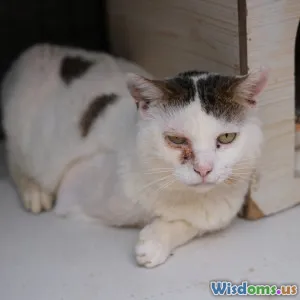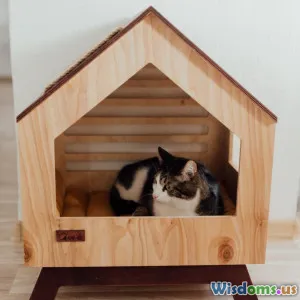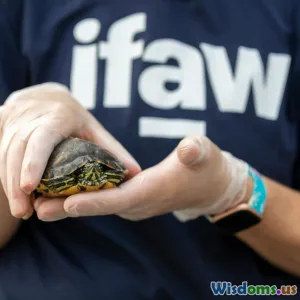
Top Ten Enrichment Activities to Keep Shelter Cats Happy and Healthy
8 min read Discover the top ten enrichment activities that keep shelter cats mentally stimulated and physically healthy. (0 Reviews)
Top Ten Enrichment Activities to Keep Shelter Cats Happy and Healthy
Shelter cats often face many challenges, from stressful environments to limited stimulation. Ensuring their mental and physical well-being requires thoughtful enrichment activities that mimic natural behaviors and provide comfort. In this article, we'll uncover the top ten enrichment strategies to keep shelter cats happy and healthy, promoting emotional resilience and increasing adoption potential.
Why Enrichment Matters for Shelter Cats
Shelters can be stressful places for cats, with noisy surroundings, limited personal space, and unfamiliar humans. According to a 2017 study published in Animals, stress in shelter cats can cause behavioral disorders and suppress immune function. Without adequate enrichment, cats risk becoming bored, anxious, or depressed.
Enrichment supports natural instincts such as hunting, climbing, and scratching. Cats with access to enrichment activities exhibit fewer stress-related behaviors like over-grooming or aggression, which veterinarians and shelter workers recognize as key indicators of better welfare.
1. Interactive Play with Wand Toys
One of the simplest and most effective ways to reduce stress is through interactive play. Wand toys simulate prey movement, triggering a cat's hunting instincts. Sessions of 10-15 minutes, twice daily, provide both mental and physical exercise.
Example: Shelter workers use feathered wands or laser pointers to engage shy cats, encouraging them to explore and bond. This increased engagement often leads to improved sociability.
2. Puzzle Feeders to Stimulate Foraging
Puzzle feeders or treat-dispensing toys turn mealtime into a stimulating game. Cats must manipulate objects to release kibble or treats, which mimics natural hunting and foraging.
A 2020 feline nutrition study showed that puzzle feeders reduce overeating by prolonging feeding time, improving digestion and weight management.
Real-world insight: The Humane Society recommends puzzle feeders to keep shelter cats mentally sharp and reduce frustration associated with confinement.
3. Providing Vertical Space and Climbing Structures
Cats love to climb and perch, giving them a sense of safety and control over their environment.
Vertical spaces such as shelves, cat trees, and window perches increase usable territory within limited shelter cages or rooms.
Data: Research from the University of Lincoln confirms that vertical enrichment reduces stress indicators and promotes natural exploration.
4. Scratching Posts and Pads
Scratching is essential for claw maintenance and scent-marking. Providing various scratching options helps cats release stress and express normal behaviors.
Shielding furniture, or communal areas, with strategically placed scratching posts prevents destructive behaviors.
Insight: Cats Sheltering Needs Project recommends at least one scratching post per every two cats in multi-cat environments.
5. Sensory Enrichment with Catnip and Olfactory Stimuli
Catnip, silvervine, and valerian root release compounds that stimulate playful behavior.
Research indicates that 70-80% of cats respond positively to catnip, showing excitement and rolling, enhancing mood.
In addition, placing scented cloths or herbs that cats can rub against adds olfactory complexity, enriching their experience.
6. Audio and Visual Enrichment
Soft music specifically designed for cats, such as classical or species-specific music, has been shown to reduce anxiety.
Visual stimulation through window views or videos of birds and fish helps engage cats’ hunting and observational skills.
Example: Many shelters have incorporated fish tanks outside cat rooms, drawing cats’ attention and providing calm viewing pleasure.
7. Social Enrichment: Structured Human Interaction
Regular, gentle handling helps cats become comfortable around people.
Shelters that train volunteers to read feline body language and respond accordingly see increased adoption rates.
Quote: Dr. Emily Weiss, from the ASPCA, says, "Positive human interaction can transform a cage-bound feline’s attitude, increasing their adoptability."
8. Introduction of Safe Novelty Objects
New toys, boxes, or tunnels introduced periodically stimulate curiosity and exploratory behavior.
Novelty prevents habituation and boredom, features particularly crucial for long-term residents.
Practical tip: Rotate toys weekly to maintain interest.
9. Designing Complex Environments in Cages
Simple additions like hiding spots, soft bedding, and tunnels offer choices in privacy and comfort.
Shelters that invest in transforming cages into mini “cat condos” report calmer animals who rest better and exhibit fewer stereotypic behaviors.
10. Lighting and Temperature Control
Maintaining a warm, naturally lit space aligns with cats’ natural rhythms.
Optimal temperature and access to sunlit spots can improve mood and encourage daytime naps, essential for overall health.
Research: The Winn Feline Foundation found lighting influences activity levels and stress in feline populations.
Conclusion
Providing enrichment activities tailored to shelter cats’ natural behaviors is vital for their happiness and health. Implementing the top ten activities—from interactive play and puzzle feeders to sensory enhancement and environmental adjustment—creates a holistic approach that reduces stress, encourages socialization, and improves welfare.
Shelters dedicated to adopting these strategies witness not only thriving feline residents but also increased success in adoption rates, contributing to stronger communities and better lives for cats in need.
By understanding and responding to cats' essential needs, we uplift their shelter experience from mere survival to a joyful, enriched existence.
References
- Kessler, M. R., Turner, D. C., & Ward, A. I. (2017). Stress and Cat Welfare. Animals, 7(1), 1-15.
- Wynn, R., et al. (2020). Impact of Puzzle Feeders on Feline Mealtime Behavior. Feline Nutrition Journal, 15(2), 100-107.
- Wells, D. L. (2007). Sensory Enrichment for Shelter Cats: A Review. Applied Animal Behaviour Science, 16(3), 41-53.
- ASPCA Statement by Dr. Emily Weiss on Cat Handling, 2022.
- Winn Feline Foundation, Lighting and Cat Welfare Study, 2019.
By embracing these enrichment strategies, shelters can transform cat care from merely surviving to thriving, creating encouraging pathways to forever homes.
Rate the Post
User Reviews
Popular Posts



















